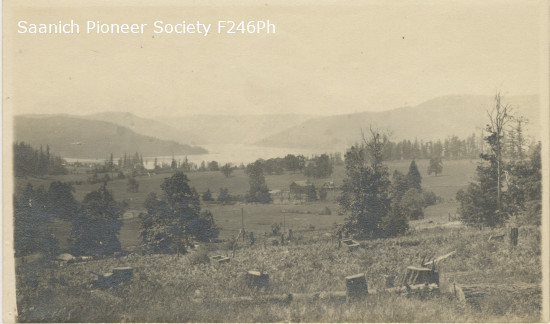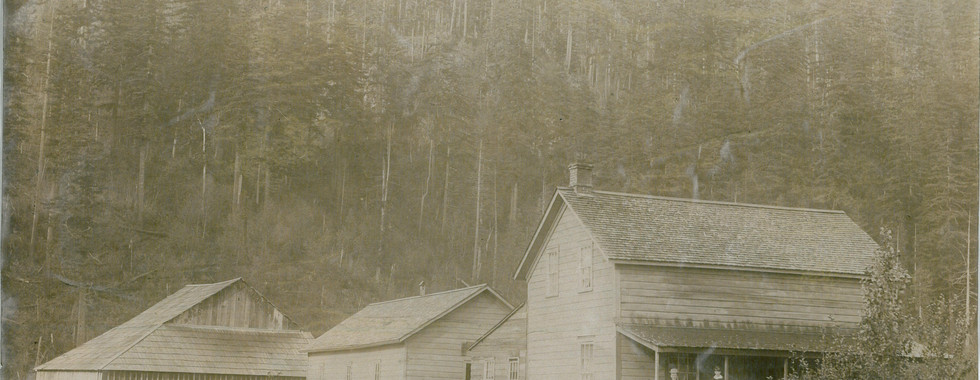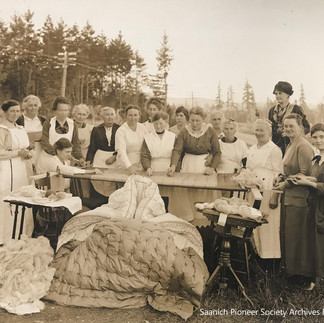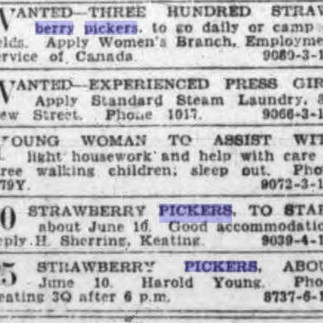Peninsula-Grown: Portraits of an Agricultural Community
- Saanich Pioneer Society

- Jul 11, 2022
- 10 min read
Farming: A Family Affair
Farming is hard work. When settlers arrived on the Saanich Peninsula, before the conveniences of modern equipment, everyone pitched in. Large families were common, and necessary, to care for livestock, work the fields, and harvest crops. For the children who grew up in this environment, it was simply a way of life.
The Butterfield family moved to Vancouver Island in 1913 and bought a 13-acre property on Mount Newton X Road which they operated as a poultry farm. Daughter Hilda (1907-1987) was born in what was then known as Port Simpson, B.C. (now called by its original Indigenous name of Lax-Kw'alaams); her father was a master mariner. Although she left to attend school in Victoria and pursue a nursing career, she came home to live with her mother after her father died in 1930. Mother and daughter worked hard, assisted by Sing, a Chinese man who lived on the property. They had a beautiful garden and grew all kinds of plants and flowers – though no chickens, as they were not fond of them! – and Hilda loved her horse named Blue.
Hilda served in Quebec during WWII. After the war, however, she returned to the Butterfield farm. Her mother died in 1961 and Hilda took over the property. According to local resident Joan Hodgson, “she could fence and plumb and until the last few years she did all the gutters herself on her high roof.”
Yours truly. I was really working when Miss Thomson arrived on the scene & snapped me. I made this shovel myself! Short dresses & bloomers were the order of the day. Taken by no. 4. chicken house - up in the woods. -Hilda Butterfield, on a photo of herself shoveling snow.
Hilda bequeathed the 13 acres, located on the northwest corner of Thomson Place and Mount Newton X Road, to the District of Central Saanich as parkland. Her home still sits in what is now Butterfield Park.
Photos:
Spencer Family
Albert Henry Spencer was born on May 25, 1876 in Newcastle-on-Tyne, England. According to his obituary, he moved to Alberta in 1916 and ranched until 1929, when he and his family moved to Brentwood Bay. They settled on a nearly 10-acre property on Verdier Avenue – listed on the 1951 Central Saanich Assessor's and Collector's Roll as South Saanich District, Section 10R1&2W, Plan 1188, Lot D, Verdier & Stelly's, 9.79 Acres, Farm.
Together with his wife Marguerite Sylvie Spencer (nee Destrubé) and children Marguerite and Ernest Henry, Albert spent his days threshing, making haystacks, ploughing fields, and tending to their animals.
Rural living in a growing area had its dangers, however, especially for children and tragedy would strike a few years later. In February 1936, the area went through a cold snap accompanied by a dump of snow. Those who are familiar with Brentwood know that Verdier Avenue is quite steep leading down to the ferry dock; back in 1936, it was a perfect sledding hill. The Daily Colonist reported on the fatality that marked the first snowfall of the year:
Ten-year old Ernest Albert Spencer, son of Mr. and Mrs. Albert Spencer, Verdier Avenue, Brentwood, was instantly killed shortly before 11 o'clock yesterday morning. Albert and his sister Margaret, twelve years old, were sleigh-riding on Verdier Avenue hill and police believe they became frightened when they saw the automobile behind them and both rolled from the sled, Margaret to the right side of the road and [Ernest] Albert to the left.
The vehicle had been driven by Edward Clayards of Bowker Avenue, who, according to the newspaper account, tried to avoid the boy. It was believed the front bumper of the car struck Ernest on the head, causing instant death. A subsequent inquest ruled the death accidental.
Despite what must have been a devastating loss for the Spencer family, they carried on. Albert Henry and Marguerite later retired, selling the Verdier property and moving to 941 Joan Crescent in Victoria, where they would spend the remainder of their lives.
Photos:
Marguerite Sylvie Spencer and daughter in front of family house on Verdier Ave (F650Ph #158)
Albert Henry Spencer beside hay stacks on Verdier Ave (F650Ph #148)
Children Marguerite and Ernest Albert Spencer in a field on the Spencer farm, with the family house in the background (F650Ph #59)
Albert Henry Spencer with his two children and farm animals, goats (F650Ph #157)
Threshing hay on the Spencer family farm, Verdier Avenue (F650Ph #78)
Farming was a way of life for most families on the Saanich Peninsula. Some of the homes, such as the Thomson family’s Bannockburn, have been preserved. The biggest change? Size – on two fronts. Much of the land of these old farms has been parceled off, and families are much smaller. With a farm to run, the more people the better!
Photos:
Beyond Hay
Farming on the Saanich Peninsula went beyond hay and livestock. Flowers became a popular, and attractive, product. The Saanich Fall Fair and flower shows provided an opportunity for professional and amateur growers to display their work.
The Butchart family was arguably one of the most successful flower growers in the area, though in this case customers flocked to enjoy their blooms on site rather than taking them away. The experience, rather than only the product, was the draw.
It didn’t start out that way. The gardens were the dream of Jenny Butchart and began as a hobby; in truth, she knew very little about gardening when she started. After her husband Robert Pim Butchart, who was involved in the manufacture of Portland Cement, moved his family from Ontario in 1904, she slowly developed the beds around their home, Benvenuto (Italian for welcome). She was inspired by what she called the “silent, ghastly tomb” of the old limestone quarry just south of their home and aimed to turn it into a little piece of paradise. The now-famous sunken gardens were created in 1910.
Jenny’s gardens soon attracted many visitors, and she served tea to them personally until numbers became prohibitive. Today, visitors from all over the world travel here to stroll through the beautiful place she envisioned.
Photos:
While Philip Holloway’s farm on East Saanich Road was known for its berries – many young ladies worked as pickers there during the summer – the family also grew flowers.

On Saturday, July 20, 1918, the Old West Road Hall (at the Keating and West Saanich Road corner) was the venue for the fourth annual flower show of the West Saanich Women’s Institute, arranged by Mrs. R.J. Parsell and judged by Mrs. R.P. Butchart. The photographer who captured it, William Henry Griffiths, worked in the small community of Sluggett's on the Saanich Peninsula. His image of the tables of flowers with the flags in the background appeared in the July 25th edition of the Victoria Daily Times.
The event was held during WWI, when many men would have been away for military service. It provided not only a chance to show off beautiful flowers, but also to raise funds for the Red Cross while enjoying a diversion from war worries.

In addition to flowers, attractive booths sold “dainty plain and fancy work”, ice cream and soft drinks, and home produce. Raffle items included fruit cake, a crochet collar, nightdresses, cushion, and pillowcases. An informal concert followed, and at the close of the show, any remaining flowers and unsold items were auctioned off in order to raise additional money for the cause. The Vancouver Portland Cement Works company donated an impressive $50.
Note the display with “Ward VI [6]” written above in greenery. In 1908, Saanich was divided into six (and later seven) administrative wards. Ward 6 seceded from the District of Saanich in 1950 to form the District of Central Saanich.
West Saanich Flower Show
F. A. Pauline. M.P.P.. will at 2 o’clock tomorrow open the annual flower show of the West Saanich Women’s Institute, to be held in the West Road Hall. In addition to the exhibition of flowers, etc., there will be numerous booths and a sale of work and home cookery. In the evening an informal concert will be given. The proceeds will be devoted to the work of the Red Cross. –Victoria Daily Times, 19 July 1918

West Saanich Show Proves Big Success
The fourth annual flower show of the West Saanich Women’s Institute, held on Saturday afternoon and evening, proved an unqualified success and reflected much credit on the ladies of the district who worked so hard to endure that result. The total proceeds amounted to $325, and after expenses are deducted a splendid sum will be available for the Red Cross and Patriotic Funds in whose aid the event was arranged.
F.A. Pauline, M.P.P., opened the exhibition which was held in the West Road Hall, and at the conclusion of his brief remarks, in which he congratulated the organizers, he was presented with a buttonhole bouquet by little Miss Roberta Sluggett. H.C. Hall, M.P.P., spoke a few words, referring to the women’s splendid work for the Red Cross and other patriotic causes emanating from the war. A pleasing little incident was the presentation of a life membership in the Red Cross to Mrs. H.J. Crocker, convener of the Red Cross committee of the Institute, Mrs. Osborne, the president, making the presentation on behalf of the members of the Institute in recognition of her untiring efforts in this branch of the work. –Victoria Daily Times, 23 July 1918
Women For Home and Country
Women’s Institutes were at the heart of rural living on the Saanich Peninsula for decades. Ladies learned new skills, and supported and empowered one another, while applying their talents to improving conditions in the home, the community, and around the world. And of course, they brought a healthy sense of competition when it came to vying for ribbons at the Saanich Fair and other shows.
In Mrs. Lilith Nimmo’s living room in about 1952, a group of women posed for a photograph each holding something relating to the Saanich Fall Fair: plump fruit, preserves in jars, freshly baked bread and other goodies, a silver prize platter. The ladies were busily preparing a display for the Fair.

Mrs. Eulalie Willoughby (nee Harrison) had earned the right to show off the prize platter, which is in her hands in the photo. The newspaper regularly published her name as a winner of agricultural-related prizes. At the 1950 Fair, she won in a whopping six classes under the Bottled Fruit and Jam Section. In May 1951, she received recognition at the Royal Oak Garden show in multiple categories: "lady's corsage bouquet and gentleman's buttonhole", "bowl of tulips arranged with one or two other flowers", and "decorated table, novice class".
Mrs. Willoughby’s work went beyond competing in fairs. She also owned and operated the Beaver Lake Store (4808 West Saanich Road) with her husband from around 1933 until 1947.
The original business was a confectionery store that she built along with her cousin on rented property on the east side of West Saanich Road. When their landlord raised the rent, they hauled the building across the road, renting and later buying the new property. Eulalie Willoughby was a rural entrepreneur.
Photos:
At Work
Labourers were needed for all kinds of agricultural and related work. When help was in short supply, neighbours came together to lend a hand, whether it was for threshing, barn-raising, or harvesting.

When it was threshing season on the John Brethour farm, Walter Thomson and Bill Turgoose were known to join in. In this photo, Walter is standing on top of the separator and Bill is bagging the grain. Volunteers regularly demonstrate the noisy, dusty threshing process at the Saanich Fair, so that residents can understand this important part of agricultural life.

Despite its name, the Saanich Cannery was located in Sidney, (at First Street and Beacon Avenue, now the site of the Sidney Waterfront Inn & Suites). The company was the enterprise of Jim White and began canning clams in 1903, but later shifted to fruit and vegetables. It employed many women for the season, possibly because they were paid less than men.



Photos:
Summer Pickings
If you wanted a job for the summer in the late 1920s and through the 1930s, you could easily pick up work as a berry picker. Workers were in demand and could come to the farm every day or stay at the rough accommodation on site. It was hard, physical work, but offered lots of opportunities for socialization with other young people and was a popular seasonal opportunity. Most workers were women.
Farmers at Keating followed the example of those in Gordon Head in planting strawberries. The Gordon Head Fruit Growers’ Association, incorporated in 1916, shipped crates of berries to the prairies – that region became their main market.
In 1910, the mayor of Port Townsend spoke at a growers meeting held at the Temperance Hall at Keating. He told them about and recommended they plant loganberries, a cross between a raspberry and a blackberry. Unfortunately, there was no market for it and much of that first crop remained on the vines.
Neil Lamont came up with an idea for the loganberries. Why not wine? After a rough start (including a lack of money for sugar to preserve the first crop until equipment could be procured, and bottles exploding because the wine was sold before fermentation had stopped), the Growers’ Wine Company was formed. The production facility was located on Quadra Street in Saanich and operated for decades.
Photos:
MARTIN, Wendy on Fruit grower float (F604Ph #3)
Bickford & Sons, C. Saanich Freight at Fruit Shed (F2015Ph #1)
Growers Wine Co. Loganberries ca. 1927 (F2083Ph #7)
Growers Wine Co. Lab ca. 1927 (F2083Ph #5)
STRAW, Percy, Margaret and Alfred when they picked berries on my place,. ca. July 1930 (F316Ph # 34a, Goddard Family fonds)
Advertisements for pickers, Daily Times, 22 May 1928
A Growing Concern
Over time, much farmland has been given over to development to meet the growing needs of a growing population. Despite the changing nature of agriculture on the Peninsula, it continues to be an important industry in the area. Food security, particularly on Vancouver Island, is a timely issue given the impacts of climate change, land costs, and challenges to supply chains. Studying the agricultural history of the Saanich Peninsula, including traditional Indigenous land use, may help guide and inform decisions going forward.



























































If you think that emergency equipment is for the "paranoid", you probably have never received a distress signal at night in the fog. I did. It's good that I took everything in advance, both a flashlight and signal flares. Now I don't experiment anymore - I only take it from a proven resource: https://gaelixmarineservice.com/safety/emergency-equipment-devices/. Everything here is official, certified, without unnecessary marketing. Just working emergency equipment devices that really save. Friends first joked about me, and now they ask for a link.
Romanian people welcome! The best online casino for you. Here you will find the latest games, with the biggest prizes on the Romanian market jocuri egt . You will have a lot of fun and win a lot of money. Register now and enjoy your time at cazinourionline.com